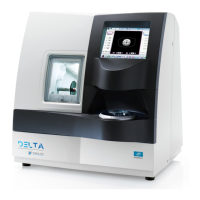As the lens is felt, its shape appears on screen. The double tracing represents the profile of the front
surface of the shape (inner shape) and its rear surface (outer shape).
2. PERFORM A BEVELING
This section describes the procedures for the creation of a bevel:
• In automatic mode (F p.98), you do not have to configure anything. All the data is automatically
retrieved from the tracer. The lens edging starts automatically after the feeling cycle.
• In customized mode (F p.99), you can opt for front/rear surface tracking, a distributed bevel,
lens curve tracking or frame rim tracking. You can also do the following:
◦ A general modification of the bevel curve (F p.102)
◦ A modification at a point of the bevel curve (F p.103)
◦ A displacement of the bevel curve (F p.104)
◦ A tilted bevel or groove (F p.105)
• You can consult the description of the customized bevel screen (F p.99).
a. Automatic beveling
Call up the desired shape located on the tracer.
The shape is displayed on the edger work screen.
After the tracing of a rimmed frame:
• The bevel finish is selected by default.
• The automatic mode is selected by default.
Select lens material.
Select the type of cycle.
Choose whether or not to polish and/or chamfer your lens.

